 | |
|  |
|
|
| |
| Less comics, more news? Booooooo | Mar 18, 2011 5:44 AM PDT | url |
| | |
Added 1 new A* page:Looks like I've only managed to fit in one page today after staying up a bit too late writing that massive Chernobyl post yesterday. Time management skills, will I ever get you? Hm I wonder if this extra gray I've been doing lately is slowing things up a bit, too. I kinda like the look of it, though. Ooh wait I know, it's because I've been having to draw two detailed characters per page for this huge brawl. Darn these crowds!
~~~~~~~~~~~
An interesting factoid I happened upon about the recent earthquake in Japan came from this Reuters photo caption, which mentions that the quake moved Japan's main island 2.4 meters (8 feet), and shifted the Earth 10 centimeters (four inches) on its axis. Dang! Ah and I see the Wikipedia page on the earthquake has that information as well...hm and it mentions that JAXA (Japan's space agency) evacuated their Tsukuba Space Center in response to the earthquake; Tsukuba is their main control center, and controls part of the International Space Station.
~~~~~~~~~~~
I linked Wikipedia's Criticality accident page yesterday, and one interesting entry on it that I hadn't gone through before is The Lady Godiva device, a test reactor used at Los Alamos in the '50's; you can see that it had a rather nifty design:
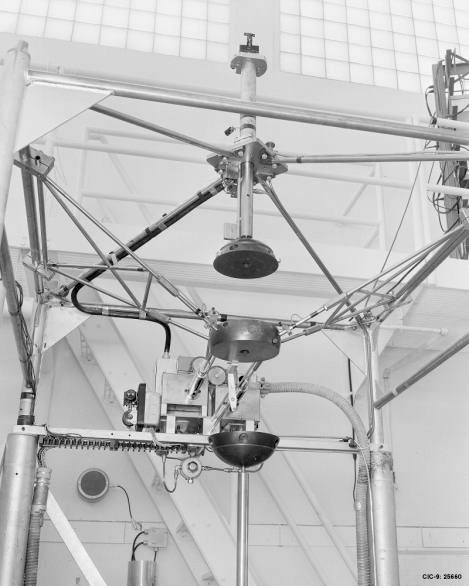
Image by USDOE (source)
Those dark hemispheres with a hole through their middle are uranium-235; when clamped together in the middle there, they would be just below critical mass; then, a rod of fissile material (maybe also uranium, I dunno) would be dropped through the middle, and in the split-second where it was falling through the uranium sphere, critical mass was reached, giving off a pulse of energy, and then the rod fell through, and critical mass was lost, so you avoided a chance of a larger radiation release.
That was the theory, at least. In practice, there were two criticality accidents with the device: the first in 1954, which did this to it:
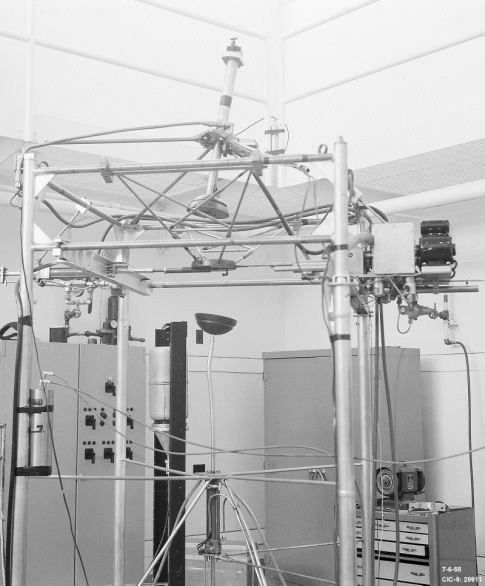
Image by USDOE (source)
and the second, damage from which forced the device's retirement, in 1957 (although it was followed up by Godiva II, which as far as Wikipedia knows is still present at the Nevada Test Site, America's primary nuclear test site (the site of 928 announced nuclear tests from 1951 to 1992 (none since then--one planned one was canceled after state Congresses objected), only 828 of which were above ground--so most of those old ground-level desert nuclear tests you see footage of now and then with army guys just standing around watching nuclear explosions as in '55's Operation Teapot
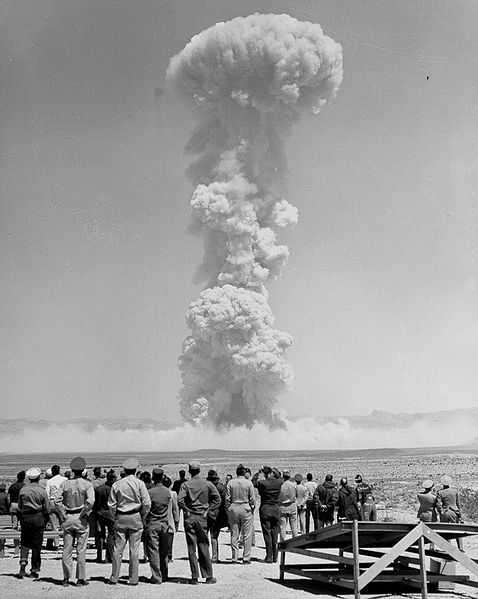
image by the US Government (source)
(ooh, pretty!), or where whole ghost towns were constructed, then nuked like this ('53's oddly named Operation Upshot-Knothole)
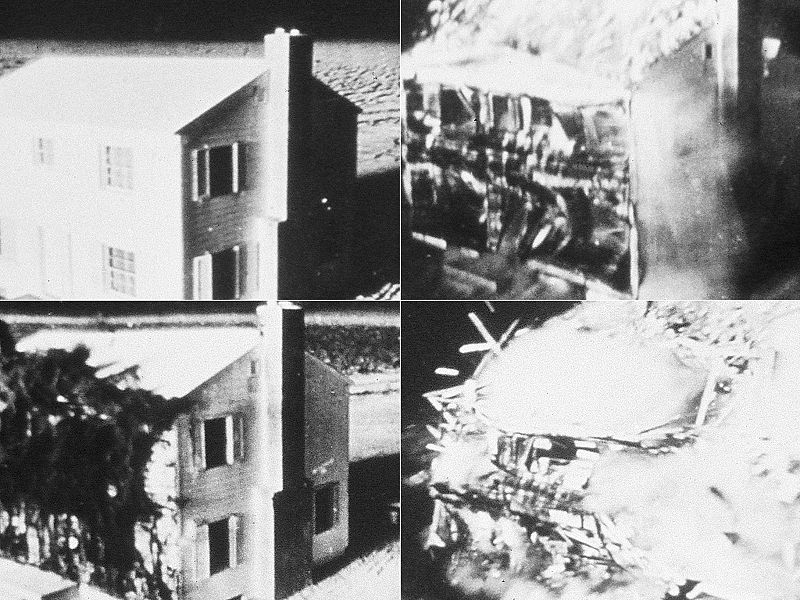
image by the US Government (source)
took place there--only 126 American nuclear tests have taken place anywhere other than the Nevada site).
Godiva's self-canceling design was inspired by a 1952 incident with its predecessor, Jemima, in which that device accidentally brought together too many of the uranium-235 disks used by it to achieve critical mass.
Interesting note for Wikipedia editors (I know you guys all read this ... :P): Wikipedia's article on the Godiva device conflates it with a 1944 test in which Otto Frisch--who named the Godiva device--caused a test device utilizing blocks of uranium to go critical when he leaned too close to it: his own body reflected additional neutrons back to the uranium stack, causing it to go critical; fortunately, Frisch saw the criticality indicator lights go solid red, and, thinking quickly, he moved away, and scattered some of the blocks; Frisch survived and lived to the ripe age of 75. Anyway, the Godiva article says it was Godiva that Frisch leaned against in '44, but it sounds like Godiva wasn't around until '52, and anyway didn't use manually stacked uranium blocks; the Otto Frisch article has a much better account of Frisch's '44 experiment (not mentioning the term "Godiva" at all): Frisch was stacking 3 cm bars of uranium hydride together, one by one, and measuring rising neutron activity as the mass approached criticality; fellow nuclear researcher Richard Feynman called this "tickling a sleeping dragon's tail," since one block too many (or, in Frisch's case, one body too many) could lead to a runaway nuclear reaction that would release enough neutrons to kill everyone in the vicinity...just like a suddenly awoken ticklish dragon would. ...
Man, they sure were nonchalant around radiation back in them days; of course, they had more immediately deadly things to worry about, like the millions of conventional bombs of WWII, which could kill you just fine right away, rather than months or years or decades later. Also, they didn't really know how nasty radiation could be to the human body. Frisch had given the Godiva device its name as a bit of a joke on this carefree attitude, since, in folklore, the medieval Anglo-Saxon noblewoman Lady Godiva is said to have ridden through the streets of Coventry, England, in the nude (to get her husband to stop his excessive taxes; the story goes that she'd been asking him on behalf of the people to repeal them, and he got testy and said he would if she rode through town naked--so she did; the question is, did he really want to a) repeal the taxes, or b) have his wife parade around in the buff? Weird guy :p), and, as Frisch put it, the device, like Lady Godiva, also was "naked and unshielded"; it didn't repeal taxes, though.
~~~~~~~~
Whoa okay, I have to backtrack and go on more about Operation Upshot-Knothole, whose eleven nuclear test shots in Nevada in '53 had quite a few knotty down-shots in them. For one thing, the shots of the first two tested uranium hydride bombs--in which deuterium (an isotope of hydrogen: it's a proton (hydrogen) plus a neutron) is used as a moderator to slow emitted neutrons, converting them to thermal neutrons, which are good for sustained nuclear reactions--fizzled, managing yields of only 0.2 kilotons each, which, in the first one's case, didn't even destroy the little tower on which the bomb was mounted:
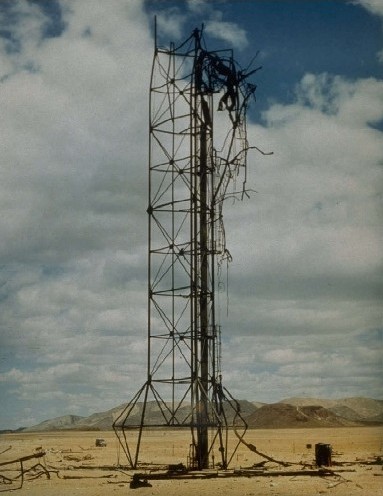
image by the US Government (source)
That kind of result sure wasn't gonna keep us safe from the reds!
The other, much worse failing in Upshot-Knothole was the Harry test, in which a 26-kiloton air-dropped bomb detonated at 2,400 feet above the test range. The explosion released much more fallout than anticipated, and winds carried the radioactive cloud 135 miles to St. George, Utah, "where residents reported 'an oddly metallic sort of taste in the air'" (there's that qualitative phrase I borrowed for A* again!); apparently, this sort of thing happened repeatedly to St. George. Jeez. Due to the accident, the press dubbed the bomb "Dirty Harry"--that's gotta be where the character "Dirty" Harry Callahan's nickname came from, right?
~~~~~~~~~
Sheesh, I gotta cut down on these huge news posts. :P But at least I cut my news backlog down by a net of one browser tab. :pp And I learned stuff, darn it.
|
·····
|
|
|
